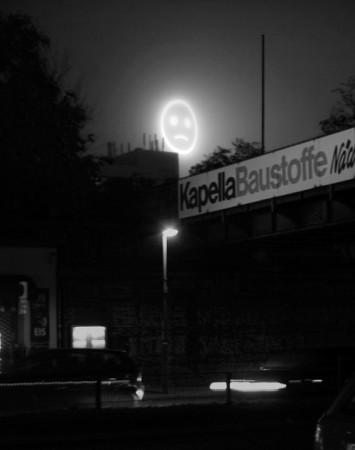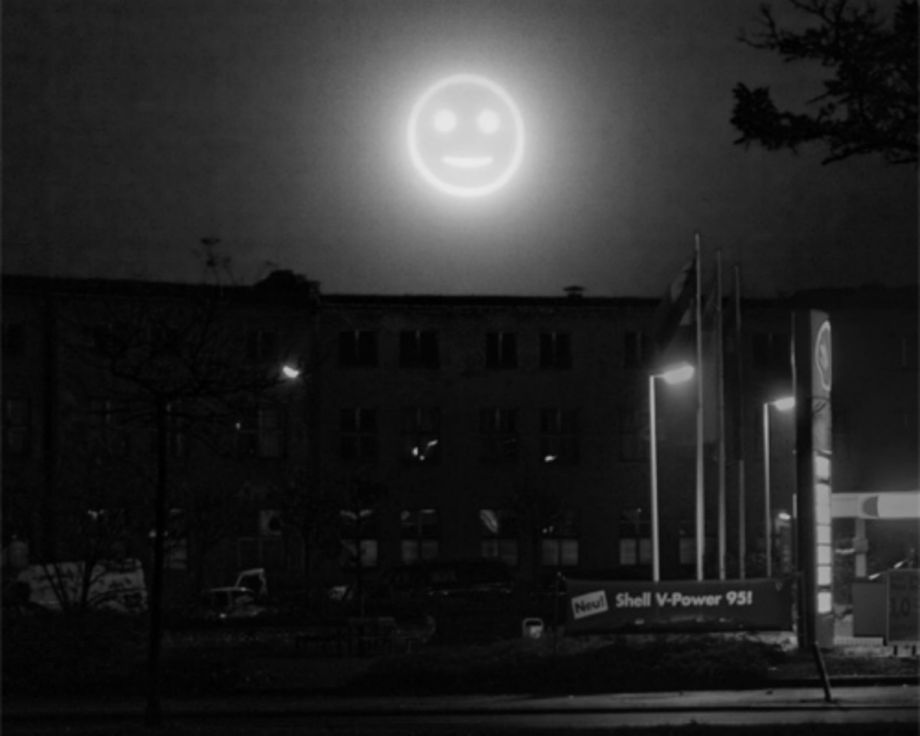Christine McLaren is the resident blogger for the BMW Guggenheim Lab. This story originally ran on the lab’s blog.
Think about the last time you saw a friend, family member or colleague smile about something that made them happy. Did you smile too? If you did, did it make you feel a little happier at the same time?
If you are an average human being, the answer to both of these questions is probably yes.
But think about this: If you were to find out that most of the people in your city were smiling about something that was making them happy, would you smile too? And would you, in turn, feel a little happier at the same time?
That, it turns out, is a much more complex question to answer.
In another post I prodded a question that is becoming increasingly relevant as society’s interest in the emotional side of city life grows: How much about a city’s emotions do we really want to know?
Sparked by a German art installation that first made tracks in 2007 known as the Feel-o-Meter—a giant neon smiley icon that analyses the emotions of a city’s citizens, and changes its expression to reflect the overall mood of the city—I dug into the pros, cons and potential that our recent interest and ability to measure the city’s emotions holds.
This project, of course, does not exist in a vacuum. Other projects such as Mappiness, the Emotional Cities project and Colin Ellard and Charles’ Montgomery’s Testing Testing experiment at the Lab, are just a few of many examples that indicate our current acute interest in not just understanding, but publicizing the feelings and emotions we experience in day-to-day city life.
But in prodding the should-we-shouldn’t-we question, there is an obvious paradigm that can’t be ignored. We can talk all we want about how this knowledge could influence policy—but what about how it would influence us, as individuals?
We are well aware of our innate ability to be influenced by the emotions of others. It’s why babies start to cry when other babies around them cry, and why we sometimes can’t help but to smile and laugh when others are smiling and laughing, even if we don’t want to.
But to what extent does this primal mechanism work on a grander scale—say, the scale of a city? Is simply knowing the overall mood of the thousands of people around us enough to tip our own emotional scale?
To try to find an answer this question, I cornered the most qualified psychologist I could think of—University of Amsterdam professor Dr. Agneta Fischer.
Former president of the International Society of Research on Emotions and steering committee member on the Consortium of European Emotion Researchers, Fischer specializes in the study of emotional contagion—or how our own emotions are influenced by those of others.
And the answer she gave me, in short, is yes… within reason.
“What most research shows is that the closer we are with others, the better it [emotional contagion] works. It also means that the more similar we are with others, the better it works,” Fischer said.
“So it depends on your frame of reference; whether you see those other people as similar to you. And that can be manipulated in many ways.”
In other words, if I live in New York, my ability to be effected by the feelings of New Yorkers would depend on the extent to which I identify as a New Yorker myself at that moment. That also means the effect would be even more exaggerated if this self-identification were emphasized by, say, comparing our emotions as New Yorkers to those of citizens in a different city.

It harkens to something we learned this fall during the Lab’s time in New York from Emanuele Castano, a social and political psychologist who focuses on the study of empathy.
In talking at the Lab about how we can look to build empathy and conviviality into our cities, Castano pointed to the social categorization process that is constantly at work in our brains. By putting people in in-groups or out-groups, depending on how we are identifying ourselves at any given moment, he said, we can actually curtail empathy toward the out-group.
At the same time, however, the opposite is true toward those in the in-group. This means that the more we identify with our fellow citizens, we are not only more likely to catch their emotions, but we’re also more likely to feel empathy toward them.
“The way that we categorize a person will have an impact on the level at which we catch the emotion,” Castano told me recently in an interview.
“Emotional contagion is one of the building blocks of empathy. It’s the first ability we need to have to develop empathy.”
But it’s not only closeness or social identity that would determine the likelihood of us catching our city’s emotions. When it comes to contagion, not all emotions are made equal.
The more specific the emotion, for instance, the more difficult it is to catch, said Fischer.
“You can catch anger, for instance, but catching disappointment is much more difficult because it’s a lot more complex to recognize those emotions. One requirement for emotional contagion is at least some sort of recognition of the emotion, or expecting the emotion,” she said.
The basic emotions—anger, fear, sadness, disgust, happiness, surprise and sometimes contempt, shame or pride—are literally easier to recognize. The more specific an emotion gets, the more specific the experience needs to be for someone else recognize, understand and therefore catch it.
“It gets more cognitively complex,” said Fischer.

It also depends on how much risk there is for us in mimicking or catching an emotion. Less risk equals stronger contagion, which ultimately points to what I would consider one of the more beautiful of all psychological processes: Happiness is more contagious than sadness.
“If you look at spontaneous mimicry, people mimic more smiles than frowns. It’s a sort of ‘low-cost.’ It’s easy to smile,” said Fischer.
Thus, a giant smiley representing the overall good mood of your city “would certainly reinforce neutral moods, and it would also work in the sense that people who are slightly happy would become more happy, and people who are neutral would become more happy. And people who are a little melancholic, yes, they would all go in the positive direction,” said Fischer.
Of course this is by no means a silver bullet solution for sustainable well-being. So let this not be misunderstood—Berliners who will see the Feel-o-Meter on a day-to-day basis upon its reinstallation should not take this as a cue to forego their meaningful pursuits.
In the end, of course, it’s not the emotion itself, but the context that really matters.
“If you realize other people are happy, the sheer fact that they’re happy, this will work—but not as something continuous… it wouldn’t work forever. People will see the smiley and mimic it, but when something else happens that will be gone, so it’s a bit superficial. So it needs more… it needs to be related to some sort of motivational relevance for the things that people do in the city,” said Fischer.
“Knowing that people are happy is effective, but knowing what’s making them happy will give the effect more endurance.”
This story was originally published on Lab|log at bmwguggenheimlab.org. © 2012 The Solomon R. Guggenheim Museum, New York. Used by permission.
Photos by Julius von Bismark









